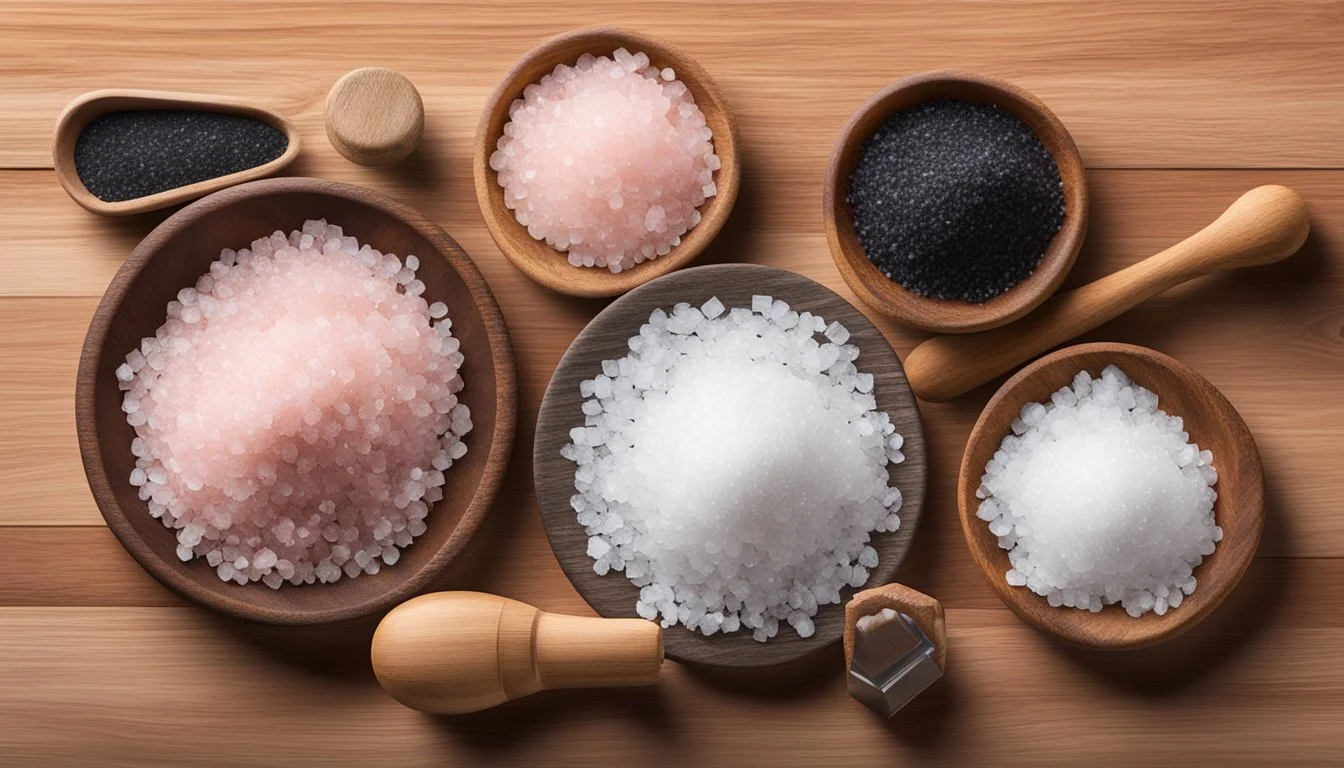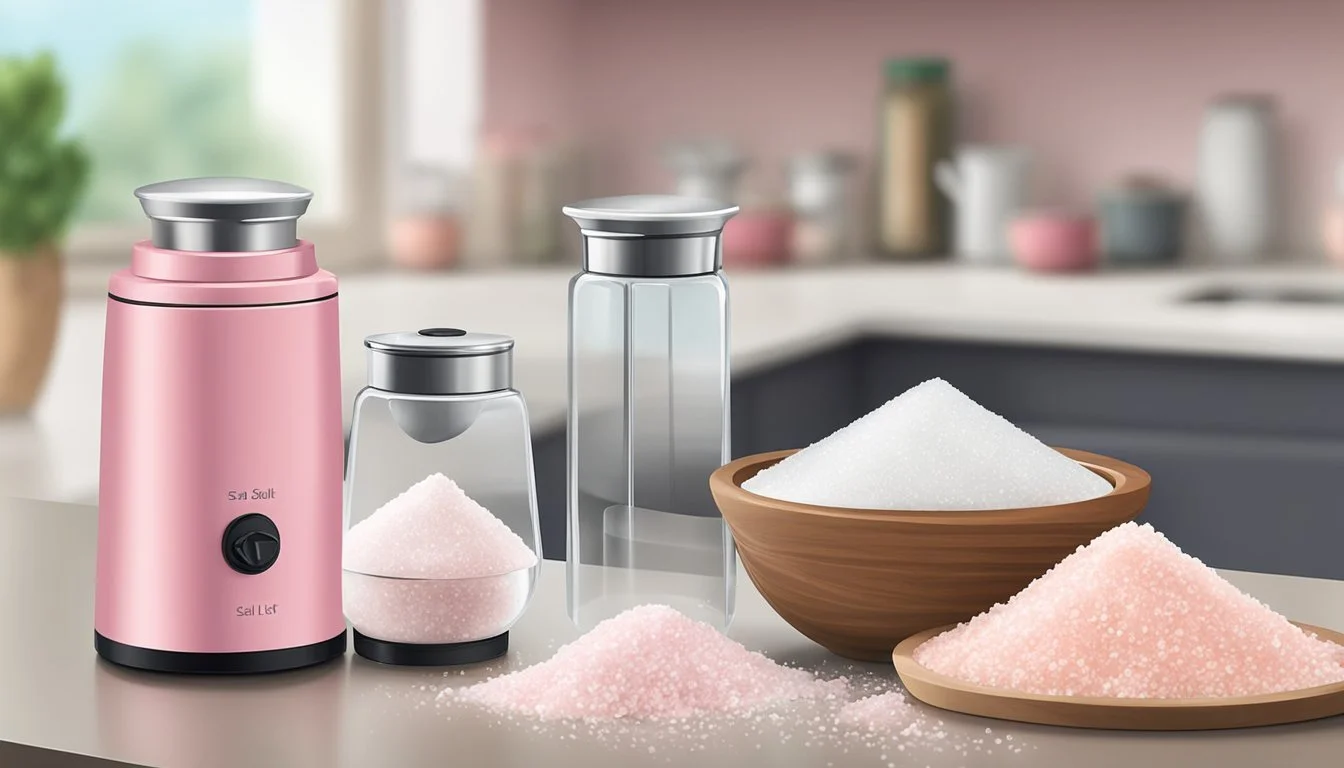Himalayan Pink Salt Substitutes
Best Alternatives for Flavor and Health
For those seeking alternatives to Himalayan pink salt, there are numerous options that can conveniently substitute in both culinary and health contexts. Sea salt, known for its varied textures from fine to coarse, is a popular alternative that offers similar mineral content and is easily available in most grocery stores. It provides a balanced flavor and can be used in the same quantities as pink salt.
In addition to sea salt, other substitutes include table salt and various salt substitutes that incorporate potassium chloride instead of sodium chloride. These options can be particularly beneficial for those looking to manage blood pressure and reduce overall sodium intake. Salt substitutes often contain beneficial minerals aside from sodium, such as potassium or magnesium, providing an alternative that may support better health outcomes.
Pink Himalayan salt is renowned for its trace elements, but it’s hand-mined nature doesn't significantly alter its basic composition compared to other types of natural salts. For those interested in both health benefits and versatility in the kitchen, these alternatives can be practical and beneficial without compromising on taste or nutritional value.
Understanding Himalayan Pink Salt
Himalayan pink salt stands out due to its unique pink hue, derived from trace minerals such as iron. Sourced primarily from the Punjab region of Pakistan, this salt is valued not only for its aesthetic appeal but also for its purported health benefits and culinary versatility.
Composition and Health Benefits
Himalayan pink salt contains up to 84 trace minerals, including magnesium, calcium, and potassium. These minerals contribute to its distinctive pink color. The presence of iron is particularly notable, lending the salt its unique hue.
While some claim that Himalayan pink salt offers health benefits like improved hydration and better mineral balance, scientific support for these assertions is limited. It does, however, provide a natural source of sodium, essential for fluid balance and nerve function. Despite these benefits, it's important to use pink salt in moderation due to its sodium content.
Culinary Uses and Characteristics
In the kitchen, Himalayan pink salt is lauded for its clean, unrefined flavor and coarse texture. It can be used as a finishing salt, sprinkled over dishes to enhance flavor. Its subtle mineral taste complements various foods without overwhelming them.
Chefs often prefer this salt for its visual appeal, as the pink crystals add an elegant touch to culinary presentations. The salt can also be used in brining and curing processes, offering a natural and mineral-rich alternative to traditional salts.
Source and Extraction in Pakistan
Himalayan pink salt is primarily mined in the Khewra Salt Mine in the Punjab region of Pakistan. This mine, one of the oldest and largest in the world, has been a source of salt for centuries. The salt is extracted manually to preserve its natural properties and maintain its purity.
The mining process involves removing large salt blocks, which are then cleaned and processed into various sizes and forms for consumer use. This traditional mining method ensures the salt remains free from pollutants and additives, maintaining its natural state.
Health Considerations of Salt Intake
Proper management of salt intake is crucial for maintaining cardiovascular health and preventing related diseases. Key factors include the impact of sodium on blood pressure, the role of potassium in mitigating risks, and recommendations from leading health organizations.
Sodium and High Blood Pressure
Excess sodium intake is a well-established cause of elevated blood pressure. When sodium levels in the body are high, it retains more water, which increases blood volume and consequently, blood pressure. Elevated blood pressure is a primary risk factor for heart disease and stroke.
The American Heart Association recommends consuming no more than 2,300 milligrams of sodium per day. Many processed and packaged foods contribute significantly to high sodium consumption. Monitoring and managing dietary sodium is essential for individuals at risk of high blood pressure and related cardiovascular diseases.
Potassium's Role
Potassium is a vital mineral that helps counterbalance the effects of sodium on blood pressure. It aids in muscle function, nerve signaling, and maintaining proper fluid balance. Consuming adequate potassium can help reduce blood pressure by promoting sodium excretion through urine and relaxing blood vessel walls.
Foods high in potassium include bananas, oranges, and potatoes. Incorporating these foods into a low-sodium diet can help manage blood pressure effectively. While potassium supplements are available, obtaining potassium through a balanced diet is generally recommended for better health outcomes.
Guidelines from Health Organizations
Leading health organizations provide clear guidelines for sodium and potassium intake to promote heart health. The American Heart Association suggests limiting sodium intake to 1,500 milligrams per day for most adults, especially those with high blood pressure or cardiovascular disease.
Health organizations also advocate for increasing potassium intake. They encourage consumption of fresh fruits and vegetables, which are naturally low in sodium and high in potassium. Adhering to these guidelines can significantly reduce the risk of high blood pressure, heart disease, and stroke.
Common Salt Substitutes
Many people seek alternatives to Himalayan pink salt for various reasons, including flavor and health benefits. Here are three popular substitutes: sea salt, kosher salt, and potassium chloride-based substitutes.
Sea Salt as an Alternative
Sea salt is derived from the evaporation of seawater. Sea salt contains trace minerals, which can add a subtle nuance to dishes. Its grains are usually larger and have a coarser texture compared to table salt. This makes it a favored option in both cooking and finishing dishes.
When used in cooking, sea salt tends to dissolve more slowly than finer salts, providing a lasting saltiness. Due to its natural origins, sea salt generally does not contain additives such as anti-caking agents or iodine.
Kosher Salt and Its Uses
Kosher salt gets its name from its role in the koshering process of meats. It has a flaky, coarse texture that makes it easy to pinch and spread. Kosher salt is highly favored in culinary applications due to its pure, clean flavor and ease of handling.
Its larger grains provide a crunch when used as a finishing salt and dissolve evenly when used in cooking. Unlike iodized salt, kosher salt does not have added iodine, which can be preferred for those seeking a more natural salt without additives.
Potassium Chloride in Salt Substitutes
Potassium chloride is a common ingredient in salt substitutes designed to help reduce sodium intake. Unlike traditional sodium chloride-based salts, potassium chloride offers a similar salty flavor without adding sodium content to dishes.
This makes it a suitable option for individuals monitoring their sodium intake for health reasons. It's available in various forms and can be used in cooking or as a table salt replacement. For some, potassium chloride may have a slightly different taste, which could take some getting used to.
Specialty Salt Substitutes
Replacing Himalayan pink salt can involve using various salt alternatives or creative combinations of spices and herbs. These substitutes offer different textures, flavors, and mineral contents to suit different culinary needs.
Using Spices and Herbs
Herbs and spices can serve as excellent substitutes for Himalayan pink salt. They can enhance flavor without the added sodium. Commonly used options include:
Garlic Powder: Adds a rich, savory flavor.
Onion Powder: Offers a subtle sweetness.
Smoked Paprika: Introduces a smoky element.
Dried Herbs: Such as thyme, rosemary, and basil, bring vibrant flavors and aromas.
These alternatives not only reduce sodium intake but also contribute additional nutrients like vitamins and antioxidants.
Alternative Salts and Their Attributes
Alternative salts can deliver similar texture and taste properties:
Sea Salt: Contains around 560 mg of sodium per quarter teaspoon and has a coarse texture.
Kosher Salt: Known for its pure salt flavor and coarse grains, it can be used in similar quantities to pink salt.
Fine Sea Salt: Similar sodium content but with a finer grain, making it easier to blend.
These alternatives also vary in mineral content, with sea salt often containing trace amounts of calcium and magnesium.
Mineral-Rich Salt Alternatives
Mineral-rich salts offer unique benefits:
Black Salt (Kala Namak): Contains sulfur compounds, imparting a distinctive flavor and aroma resembling eggs.
Celtic Sea Salt: Rich in minerals like calcium and magnesium, this salt offers a slightly moist texture.
Rock Salt: While coarse and larger in crystals, rock salt, also known as Halite, can provide similar mineral advantages to Himalayan pink salt.
These salts often contain iron oxide, calcium, and trace minerals, providing additional nutritional value while enhancing the taste.
Cooking and Food Preparation
Using Himalayan pink salt substitutes in cooking and food preparation can alter the flavor and texture profiles of dishes. Adjustments will be necessary to maintain desired outcomes, especially in baking.
Adjusting Recipes for Salt Substitutes
When replacing Himalayan pink salt, the size and texture of the salt crystals can affect the overall salinity and food texture. Coarse sea salt or flaky sea salt can be used, yet they might require slight adjustments in quantity. For instance, using a 1:1 ratio for flaky sea salt may be appropriate, but it's important to taste and adjust the seasoning as needed.
For meat curing, saltpeter or celery powder serve well as substitutes. Saltpeter effectively removes moisture, preventing bacterial growth. Meanwhile, celery powder can offer similar preservation qualities with a natural flavor.
Rock salt is another alternative, sharing many characteristics with Himalayan pink salt. Careful measurement is key, as the crystal size can affect the consistency of the saltiness. It is advisable to start with a smaller amount and increase gradually.
Baking Considerations
Baking with salt substitutes requires precise measurements to maintain the chemical balance in recipes. Substituting Himalayan pink salt with coarse sea salt or rock salt can be done, but attention must be paid to the crystal size. Smaller grains dissolve differently than larger crystals, potentially impacting the final texture of baked goods.
In recipes such as bread or cake, where salt aids in fermentation and enhances flavor, it’s critical to test the substitution’s effects. Using flaky sea salt, for instance, might necessitate slight modifications to the liquid ingredients to achieve the right dough consistency.
Considering these factors, bakers should remain cautious and willing to experiment with the quantities to perfect the recipe. Adjusting based on taste and texture ensures the desired outcome is met accurately.
Nutritional Information and Labeling
When choosing a Himalayan pink salt substitute, it is important to be aware of the nutritional information and labeling to manage sodium intake effectively. Understanding nutrition labels helps in making informed choices, while regulatory standards ensure consistency and safety.
Understanding Nutrition Labels
Nutrition labels offer essential information for monitoring sodium content. Himalayan pink salt typically contains about 420 mg of sodium per quarter teaspoon compared to 590 mg in table salt. This difference may affect dietary choices.
Various brands may list different sodium levels. Hence, always check the nutrition label. Sodium intake should align with dietary guidelines, aiming for less sodium than grams in the serving size or calories. For instance, a 100-gram serving size should preferably have less than 100 mg of sodium.
Processed foods often have higher sodium content. Reading labels assists in identifying healthier options. Key points to look for include sodium levels, calories, and serving size.
Regulatory Standards
Regulatory standards by organizations like the USDA ensure that nutritional labeling is accurate and standardized. Proper labeling allows consumers to compare different salt types and make informed choices.
USDA guidelines stipulate precise labeling for sodium content. Compliance with these regulations is mandatory for food manufacturers.
Regulatory standards also cover the mineral content in marketed salts, ensuring the trace minerals such as calcium, magnesium, and potassium listed are accurate. This transparency supports dietary planning and encourages better nutrition choices based on reliable information.
Lifestyle Considerations
Adopting Himalayan pink salt substitutes can benefit specific dietary needs and seamlessly integrate with various meal plans.
Dietary Needs for Special Populations
For those on a low-sodium diet, salt substitutes like potassium chloride can help reduce sodium intake while maintaining the salty flavor. Healthier alternatives can also be beneficial for individuals with high blood pressure or heart disease, reducing risks associated with excessive sodium.
Pregnant women might prefer salt substitutes to avoid potential complications arising from high sodium levels. Similarly, people following vegetarian or vegan diets may find plant-based alternatives like nutritional yeast or blended herbs enhance their meals without excessive salt.
Adhering to dietary guidelines helps in achieving a balanced diet for all, including special populations. Careful selection of substitutes can make a significant difference.
Incorporating Salt Substitutes in Various Diets
Incorporating salt substitutes into various diets involves creativity and understanding flavor profiles. Garlic powder, onion powder, and other herb mixes can enhance flavors in vegetarian and vegan dishes without the need for salt.
For those on a balanced diet, utilizing citrus zest or vinegar can provide the tangy kick often relied on from sodium. People on specialty diets, such as low-sodium regimes, can opt for potassium salt or salt-free seasoning blends.
Experimenting with different substitutes in various recipes ensures flavor retention and adherence to health guidelines. For example, nutritional yeast adds a cheesy flavor to vegan dishes, while coconut aminos can be an alternative to soy sauce, offering a sweet-savory profile with less sodium.
Environmental and Ethical Aspects
When considering substitutes for Himalayan pink salt, it is crucial to evaluate both the environmental and ethical implications of salt production. Key concerns include the impact of mining practices and the presence of microplastics in sea salts.
Salt Mining Impact
Mining Himalayan pink salt, predominantly sourced from the Khewra Salt Mine in the Punjab region of Pakistan, poses significant environmental challenges. The mining process involves drilling and blasting to extract the salt, which can lead to habitat disruption and landscape alteration.
Additionally, as a non-renewable resource formed through ancient seawater evaporation, excessive mining of Himalayan salt raises concerns about long-term sustainability. The limited supply means that continued high demand could deplete these ancient reserves.
Worker conditions in Khewra also warrant ethical scrutiny. Miners often work in challenging environments with insufficient safety measures, raising questions about fair labor practices and employee welfare.
Microplastic Concerns in Sea Salts
Sea salts, often suggested as substitutes for Himalayan pink salt, face their own environmental challenges. One primary concern is contamination by microplastics. These tiny plastic particles, originating from pollution, find their way into seawater and subsequently into sea salts during the evaporation process.
Microplastics in sea salts have been detected globally, raising alarms about potential health risks. Consumption of microplastic-contaminated salt may introduce harmful substances into the human body. Therefore, consumers must weigh the environmental benefits of opting for sea salts against the potential health risks posed by microplastics.
To make informed choices, it is important to consider both the environmental footprint of mining practices and the purity of sea salts available in the market.
Consumer Products and Usage
Himalayan pink salt can be found in various consumer products that offer both culinary and aesthetic benefits. These products include salt grinders, mills, bath salts, and salt lamps, catering to different needs and preferences.
Salt Grinders and Mills
Salt grinders and mills are popular tools for using Himalayan pink salt in cooking and seasoning. They come in various designs, from manual to electric grinders. These devices allow users to adjust the coarseness of the salt, ensuring that dishes are seasoned perfectly.
Quality grinders and mills are often equipped with durable ceramic or stainless steel mechanisms. This ensures longevity and efficient grinding. Using a salt grinder or mill can enhance the cooking experience by providing freshly ground salt, which has a more robust flavor and aroma compared to pre-ground salt.
Specialty Products like Bath Salts and Lamps
Himalayan pink salt is also available in specialty products like bath salts and salt lamps. Bath salts are used for their purported therapeutic benefits. They are believed to help with relaxation, skin care, and detoxification. Typically, these bath salts are dissolved in warm water to create a soothing bath experience.
Salt lamps, crafted from large chunks of Himalayan pink salt, are marketed for their aesthetic appeal and potential health benefits. The lamps emit a warm, soothing glow when lit. Advocates suggest that salt lamps may improve air quality by releasing negative ions, though scientific evidence supporting these claims is limited.







